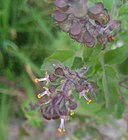Note: This is a project under development. The articles on this wiki are just being initiated and broadly incomplete. You can Help creating new pages.
Difference between revisions of "Ocimum tenuiflorum - Tulsi plant"
(→Photo Gallery) |
(→Photo Gallery) |
||
| Line 64: | Line 64: | ||
Image:Ocimum tenuiflorum1.jpg | Image:Ocimum tenuiflorum1.jpg | ||
| − | + | 7573045220 dcaf234dee z.jpg | |
Image:Ocimum tenuiflorum2.jpg | Image:Ocimum tenuiflorum2.jpg | ||
Image: Ocimum tenuiflorum inflorescence closeup.jpg | Image: Ocimum tenuiflorum inflorescence closeup.jpg | ||
Revision as of 10:14, 24 September 2018
Tulsi is a scared plant in Hindu belief. Hindus regarding it as an earthy manifestation of the goddess Tulsi, she is regarded as a great worshipper of the god Vishnu. The plant is cultivated for religious and medical purposes, and for its essential oil.
Contents
- 1 Uses
- 2 Parts Used
- 3 Chemical Composition
- 4 Common names
- 5 Properties
- 6 Habit
- 7 Identification
- 8 List of Ayurvedic medicine in which the herb is used
- 9 Where to get the saplings
- 10 Mode of Propagation
- 11 How to plant/cultivate
- 12 Commonly seen growing in areas
- 13 Photo Gallery
- 14 References
- 15 External Links
Uses
Fever, Common Cold, Sore throat, Headache, Eye problems, Dental problem, Skin disorde, Insect bites, Kidney stone
Parts Used
Chemical Composition
Carvacrol, caryophyllene, eugenol, linalool, urosolic acid[1]
Common names
| Language | Common name |
|---|---|
| Kannada | |
| Hindi | |
| Malayalam | |
| Tamil | |
| Telugu | |
| Marathi | NA |
| Gujarathi | NA |
| Punjabi | NA |
| Kashmiri | NA |
| Sanskrit | |
| English | Agrimony |
Properties
Reference: Dravya - Substance, Rasa - Taste, Guna - Qualities, Veerya - Potency, Vipaka - Post-digesion effect, Karma - Pharmacological activity, Prabhava - Therepeutics.
Dravya
Rasa
Tikta (Bitter), Kashaya (Astringent)
Guna
Laghu (Light), Ruksha (Dry), Tikshna (Sharp)
Veerya
Ushna (Hot)
Vipaka
Katu (Pungent)
Karma
Kapha, Vata
Prabhava
Habit
Identification
Leaf
| Kind | Shape | Feature |
|---|---|---|
| Simple | The leaves are divided into 3-6 toothed leaflets, with smaller leaflets in between |
Flower
| Type | Size | Color and composition | Stamen | More information |
|---|---|---|---|---|
| Unisexual | 2-4cm long | Yellow | 5-20 | Flowers Season is June - August |
Fruit
| Type | Size | Mass | Appearance | Seeds | More information |
|---|---|---|---|---|---|
| 7–10 mm (0.28–0.4 in.) long pome | clearly grooved lengthwise, Lowest hooked hairs aligned towards crown | With hooked hairs | {{{6}}} |
Other features
List of Ayurvedic medicine in which the herb is used
- Vishatinduka Taila as root juice extract
Where to get the saplings
Mode of Propagation
How to plant/cultivate
A plant of the moist to wet, lowland tropics, where it is found at elevations up to 1,000 metres[3]
Commonly seen growing in areas
Trophical, Subtrophical, Warm fields.
Photo Gallery
References
External Links
- Ayurvedic Herbs known to be helpful to treat Fever
- Ayurvedic Herbs known to be helpful to treat Common Cold
- Ayurvedic Herbs known to be helpful to treat Sore throat
- Ayurvedic Herbs known to be helpful to treat Headache
- Ayurvedic Herbs known to be helpful to treat Eye problems
- Ayurvedic Herbs known to be helpful to treat Dental problem
- Ayurvedic Herbs known to be helpful to treat Skin disorde
- Ayurvedic Herbs known to be helpful to treat Insect bites
- Ayurvedic Herbs known to be helpful to treat Kidney stone
- Herbs with Flowers used in medicine
- Herbs with Leaves used in medicine
- Herbs with common name in English
- Habit - Herb
- Index of Plants which can be propagated by Seeds
- Index of Plants which can be propagated by Cuttings
- Herbs that are commonly seen in the region of Trophical
- Herbs that are commonly seen in the region of Subtrophical
- Herbs that are commonly seen in the region of Warm fields
- Herbs




